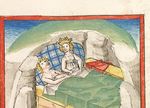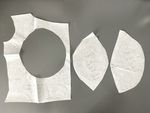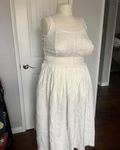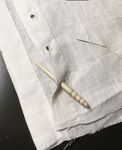The Lengberg Castle "Bra"
←
→
Page content transcription
If your browser does not render page correctly, please read the page content below
The Lengberg Castle “Bra”
Lady Apel von Mülln
Dreiburgen Summer Arts and Sciences Championship
July 2021
Image 1: “Bra,” Lengberg Castle, Austria. ca. 15th Image 2: My reconstruction. Image 3: Side view.
century.
Introduction and Background Material
During an extensive reconstruction project at Lengberg Castle in East Tyrol, Austria, in 2008,
archaeologists discovered a deposit of dry, discarded material beneath the oorboards on the
second oor, among which was found more than 2,700 textile fragments dating from the 15th
century. Among these textile fragments were a number of almost completely preserved pieces
of clothing, as well as fragments of linen lining of women’s garments, children’s clothes,
remnants of pleated linen shirts, and what appear to be supportive linen undergarments,
including a (formerly) skirted bodice with “breast bags” [Image 1] (Nutz and Stadler 2012, p.
79).
Fashion historians who have examined the nds at Lengberg castle hypothesize that the there
is correlation between supportive undergarments such as this skirted bra and the tailoring of
the gowns worn over them. For example, a skirted bodice with “breasts bags” allows for
“looser tailoring of the gown, which accentuates two separate breasts, as opposed to
1
fl
fi
flsupportive kirtles which result in a monobosom (one curving mound)” (ibid.). This garment
served as the layer worn next to the skin, with additional layers of garments, including a smock
and a gown and possibly another in between them (ibid., p. 171).
While only the front and some of the left side of the bodice of this medieval “bra” remain, there
is enough left of the garment to understand how it was originally constructed. Case, McNealy,
and Nutz write:
The cups are constructed in two vertical halves which are cut on the straight of the
grain, but are not quite symmetrical: the outer cup halves have a slightly steeper curve,
which may have counteracted the ‘east-westing’ phenomenon, in which the breasts
would have tended to face away from each other if the two halves of the cups were the
same size and shape…
There is also an indication that there was a center seam in the rib cage area of the front
of the skirted bra… The space between the cups of the extant bra now has only
fragments of needle lace remaining, but probably also held a sprang inset connected
to a ngerloop braid with simple needle lace…
[The narrow hem] has sewing holes in it indicating that there was originally stitching
along that edge. This indicates the presence of attached skirts…
The body of the skirted bra ends at what was most likely the natural waistline, just
below the ribcage. Narrow shoulder straps made of fabric strips folded in half and
whip-stitched closed remain intact… (Case, McNealy, and Nutz 2017, p. 170).
While there is no physical evidence of supportive undergarments with “breast bags” before the
discoveries at Lengberg, there are several pictorial and written sources that reference similar
types of garments. Henri de Mondeville wrote in his medical treatise Cyurgia (1306-1320),
“Some women unable or unwilling to resort to a surgeon, or not wanting to reveal their
indecency, insert two bags in their chemises, adjusted to the breasts, tting tight…” (Paulson
2016). One satirical poem written by an anonymous 15th century author from southern
Germany known only as“Meister Reuauß” penned the following:
Many [a woman] makes two bags for the breast
With them she roams the streets,
So that all the guys look at her,
And see what beautiful breasts she has got;
But whose breasts are too large,
Makes tight pouches,
So there is no gossip in the city,
About her big breasts (ibid.).
Manuscripts dating from the mid-15th century begin to depict similar undergarments with
pleated or gathered skirts. These skirted garments do not feature the separate cups as the
extant garment from Lengberg, but they nonetheless depict the wearer’s breasts as separate
and lifted (ibid.) [Images 4-6]. Case, McNealy, and Nutz summarize:
Many of these manuscripts also show a particular gown style, which features pleats
in the front just under the bust and sometimes ‘apple breasts.’ The construction of these
gowns requires support for the breasts in an underlayer. The presence of the ‘skirted bra’
and an extant gown of this pleated type in the Lengberg finds supports the idea that the
2
fi
fiunderlayer consisted of a supportive garment. Without this supportive layer, the profile of
the breasts would change, and would not appear as separate, lifted breasts (ibid.).
Image 4: Detail of a tailor by Image 5: Hofämterspiel, Image 6: Detail of “The Jerome
Konrad van Ammenhausen, 1467. Kunsthistorisches Museum, Aventiure: Friedrich and Jerome
Vienna, ca. second half in bed together,” Cod. Pal. Germ.
15th century. 345, f 247r, c. 1470.
Pattern and Construction
In keeping with the extant piece and extant practices, I chose a mid-weight, white linen and
waxed linen thread for my reconstruction [Images 2 and 3]. I used a combination of back,
running, and whip stitches, all of which were used in the extant garment (Case, McNealy, and
Nutz 2017, p. 171).
For my pattern, I altered an existing pattern I had for my Bootstrap Fashion dress form, which
had been previously generated using my measurements. The dress form pattern had nearly the
exact seam placements I would need for this reconstruction, I just needed to draft an
additional seam for the top half of the “breast bag” to create the two vertical halves of the cup
and the hole in which the bag would be sewn [Image 7 and 8]. I then drew a front and back
neckline low enough to be comfortably worn under a 15th century gown.
I did, however, omit the deep, curved vee that the extant garment has between the breast
bags, opting for a simple scooped neckline instead as I was unprepared to attempt any
experimental needlelace or sprang panel that was part of the original.
Placing right sides together, I sewed the center front and center back seams using tiny back
stitches before at felling the seams down. Using small whip stitches for added strength, I
stitched the pairs of cup halves together and then stitched each breast bag into their
respective openings. I clipped access seam allowance and felled the seams.
3
flImage 7: Sketch of adjustments made Image 8: Pattern draft of front bodice piece and cup halves.
to dress form pattern to create front
bodice piece and cups.
Following the extant example, I created narrow shoulder straps by folding strips of linen in half
and whip-stitched them closed and sewed them to the bodice pieces. I nished all other raw
edges by folding over twice and hemming them with whip stitches.
While the extant garment is missing its right side and it is unknown whether it had lacing on
this side as well, researcher Rachel Case included lacing on both sides of her own
reconstruction, hypothesizing that “lacing along one side would misalign the garment if the
wearer gained weight and the lacing needed to be loosened” (ibid.). Following her example, I
included lacing on both sides to better accommodate any weight uctuation I may experience
in the future. I atlined the side edges of the bodice pieces with additional strips of linen for
strength, folded over twice, and then whip stitched down. Then, using a bone awl, I opened
several eyelets along the reinforced side seams [Image 9]. In keeping with the original, I hand
bound the eyelets using simple whip stitches with additional waxed thread [Image 10] (Case,
McNealy, and Nutz 2017, p. 170). The eyelets were staggered so that the bra dress could be
spiral laced at the sides; spiral lacing being the method of choice in period [Image 3]. While it is
plausible that garments such as these would have been laced using ngerloop braided cord, I
opted for natural linen cord from Burnley and Trowbridge as I was not prepared to ngerloop
braid such a heavy-duty laces for the project (Nutz 2014, p. 116).
I made a simple skirt from two rectangles of linen, roughly the length of my waist to mid-calf. I
sewed the sides together to make a tube, leaving the top 8 inches or so open to help with
getting the nished garment on and o . I then felled the side seams and hemmed the top and
bottom of the skirt. By using the “divide and conquer” method, I knife pleated the top edges of
the skirt and then whipped it to the bodice.
4
fi
fl
ff
fl
fi
fi
fiImage 9: Creating the eyelet holes. Image 10: Completed hand-bound eyelets.
Lessons Learned
Sewing a fabric bag to contain something as pseudo-spherical as a human breast is very
di cult and it took several attempts and lots of basting to ease the cup pieces into the round
openings in the front pieces. Next time, I would like to add more eyelets for lacing in hopes of
creating a smoother line when the laces are pulled taught [Image 3]. With more time, I would
have liked to experiment more with the use of grainlines to achieve a better t. In retrospect, I
could have made the skirt of the dress narrower, resulting in less fullness around the waist;
after all, this is supposed to be worn under one’s clothes. In the future, I would also like to
attempt the needlelace (or possibly sprang) panel that is supposed to be between the breast
bags. Case, McNealy, and Nutz hypothesize that having a stretchy panel and clever shaping
“may have helped the bra lie close to the body,” as well as “helped the cups lie at, and…
provided coverage for the décolletage (ibid.).
References and Sources Cited
Case, Rachel, Marion McNealy, and Beatrix Nutz. “The Lengberg Finds: Remnants of a lost
15th Century Tailoring Revolution.” Archaeological Textiles-Links Between Past and Present
NESAT XIII, 2017. https://www.academia.edu/36284885/The_Lengberg_Finds_Remnants_
of_a_lost_15th_century_tailoring_revolution_NESAT_XIII
Nutz, Beatrix. “No Shame in Braiding. 15th Century Fingerloop Braids from Lengberg Castle.”
Estonian Journal of Archaeology 18/2, 2014. https://www.academia.edu/8501549/
DRGENS_SN_WIR_VS_NVT_SCHAME_No_Shame_in_Braiding_15th_Century_Fingerloop_Brai
ds_from_Lengberg_Castle_In_Estonian_Journal_of_Archaeology_18_2_2014
Nutz, Beatrix. “All Indecent! 15th century Linen Underwear from Lengberg Castle, East Tyrol,
Austria.” Autumn 2012 Meeting of the Medieval Dress and Textile Society (MEDATS), London.
https://www.academia.edu/3225965/
All_indecent_15th_century_linen_underwear_from_Lengberg_Castle_East_Tyrol_Austria
5
ffi
fi
flNutz, Beatrix and Harald Stadler. “How to Pleat a Shirt in the 15th Century.” Archaeological
Textiles Review 54, pages 79-91, 2012, https://www.academia.edu/3213526/
How_to_pleat_a_shirt_in_the_15th_century._In_Archaeological_Textiles_Review_54_2012_79-9
1
Paulson, Ula. “The Lengberg Castle Bra.” 2016. https://www.academia.edu/29427876/
The_Lengberg_Castle_Bra
Additional Photos
6You can also read



























































